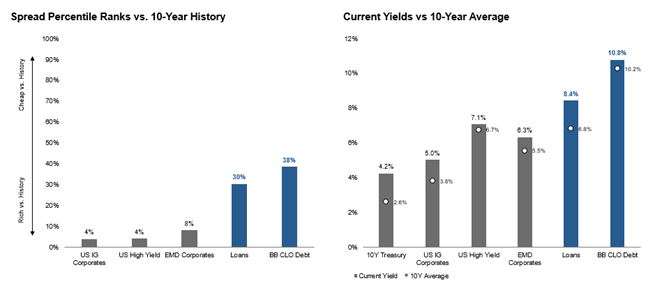Now that the long-awaited Fed rate cut has arrived – to the tune of 25 bps – bond investors have the right to ask: So what? As managers of bank loans, here’s our answer: we see it as a good occasion to show why loans deserve consideration for a traditional bond portfolio, especially in this environment. Consider:
- Yields and spreads are attractive. The current yield on loans of 8.4% (as of Aug. 31, 2025) is 150 bps higher than its 10-year average, and 60 bps ahead of high-yield bonds, the nearest competition among major fixed income sectors (Display 1). While no bond sector is particularly cheap, loans stand out as significantly less expensive than other sectors, based on spreads relative to their 10-year averages. If and when loan rates eventually float down with short-term rates, keep in mind loan yields today start with a significant advantage.
Loan spreads and yields indicate value relative to other bond sectors.

Source: Leveraged Commentary & Data (LCD), ICE Data Indices, LLC, JPMorgan. As of Aug. 31, 2025. Data provided is for informational use only. See end of material for important additional information and disclosures. Loans represented by Morningstar LSTA US Leveraged Loan Index. US High Yield represented by ICE BofA US High Yield Index. US IG Corporates represented by ICE BofA US Corporate Index. 10Y Treasury represented by ICE BofA Current 10Y US Treasury Index. EMD Corporates represented by the J.P. Morgan Corp. EM Bond Index (CEMBI) Broad Diversified. BB CLOs represented by the BB portion of the J.P. Morgan CLOIE Post-Crisis Index. Spread data measures OAS except for loans, which uses discounted spread to 3 years. is not possible to invest in an index. Past performance is not a reliable indicator of future returns.
Loan spreads and yields indicate value relative to other bond sectors.
DISPLAY 1

Source: Leveraged Commentary & Data (LCD), ICE Data Indices, LLC, JPMorgan. As of Aug. 31, 2025. Data provided is for informational use only. See end of material for important additional information and disclosures. Loans represented by Morningstar LSTA US Leveraged Loan Index. US High Yield represented by ICE BofA US High Yield Index. US IG Corporates represented by ICE BofA US Corporate Index. 10Y Treasury represented by ICE BofA Current 10Y US Treasury Index. EMD Corporates represented by the J.P. Morgan Corp. EM Bond Index (CEMBI) Broad Diversified. BB CLOs represented by the BB portion of the J.P. Morgan CLOIE Post-Crisis Index. Spread data measures OAS except for loans, which uses discounted spread to 3 years. is not possible to invest in an index. Past performance is not a reliable indicator of future returns.
- Loans are a potential hedge against rising rates and/or inflation. Remember that the Fed only controls the short end of the curve. So, hedging the possibility of rising rates at the long end – because of inflation and/or other factors – can be a wise move. Loans have zero duration, which means that they don’t lose value as long-term rates tick up, as long-term bonds do. To see the impact loans can have on a bond portfolio, consider an initial allocation of 100% bonds. Over the past 10 years ended June 30, 2025, it had a total return of 1.8%, with a standard deviation (volatility) of 5%. Had that portfolio been composed of 50% bonds and 50% loans, total return would have risen to 3.5%, with volatility dropping to 4.0%.1
- Lower rates can be a tailwind for loan issuers. Fed easing would further support consumption and consumer activity, which represents 70% of U.S. GDP. Loans have performed well during the early stages of easing prior to September’s cut, and they showcased their durability throughout the Fed’s nearly three-year tightening cycle. The economy has shown resilience this year, and earnings among leveraged issuers continue to grow, albeit at a slower pace. To the extent lower rates going forward support growth, the fundamentals and credit metrics of loan issuers should benefit. Issuers are also helping themselves through a reduction in speculative new issuances – that’s a positive from both fundamental and technical perspectives.
- Technical factors are also supportive of loans. In the past quarter, there has been a reduction in opportunistic refinancing, which reduces loan supply. While refinancing activity is expected to continue, M&A-related supply remains below expectations, constrained by macro uncertainty and tighter deal multiples. In a related trend, more aggressive transactions are increasingly finding homes in private credit markets. Moreover, the loan investor base remains predominantly stable and sticky, anchored by institutional investors such as insurance companies and pension funds that allocate to loans directly or through structured products.
- Macro uncertainty has abated, but still there. On the positive side, the “One Big Beautiful Bill Act” has stimulative measures, like the increased amount of debt leveraged issuers may deduct from taxes, and the tax cuts for businesses and consumers. Thus, we are likely to see larger 2025 tax refunds, and possibly more stimulus ahead of the 2026 mid-term elections. The macro picture has also benefited from a growing list of tariff deals and a de-escalation of tensions in the Middle East. As a result, equities are again near all-time highs, bond spreads remain tight, and the resilience in macro data has reinforced a return in confidence across risk assets, including leveraged finance.
Where do we see potential clouds? The August inflation numbers – a monthly rise of 0.4% and 2.9% over the past year – were both the most since January. At the same time, a weakening job market could confront the Fed with a stagflationary tug-of-war of economic indicators. Such a scenario could induce volatility, especially with the rich valuations in both equity and bond markets. Loans wouldn’t be immune, but have something of a price cushion, given that their valuations are cheaper than other bond sectors.
The importance of active loan management
This review underscores the reasons we believe that the loan market heads into the fourth quarter on solid footing. Of course, risks remain – as noted, loans are cheaper than other sectors, but we do not view them as cheap on an historical spread basis.
This underscores the importance of careful credit selection and active portfolio management for navigating the evolving landscape. Loan issuers span the broad spectrum of businesses and vary in their ability to adapt as the economy changes. Thus, the competing forces in today’s environment, -- between slowing growth and inflationary pressures -- make an active investment approach vital – one that has the flexibility to adjust positioning as credit and market conditions may warrant.
As always, we remain as focused on our portfolio companies; no matter the backdrop, we believe careful credit risk management is the best course to navigating this market, and this is the very centerpiece of our approach.
1 Past performance is no guarantee of future results. Source: Morningstar as of June 30, 2025. Calculation in USD assumes reinvestment of dividends and capital gains, but does not include sales charges and fees. It is not possible to invest directly in an index. Loans represented by the Morningstar LSTA US Leveraged Loan Index. Bonds represented by the Bloomberg US Aggregate Bond Index.
Floating-Rate Loans Team
As a pioneer in the floating-rate loan market, the team is dedicated to loan market investing and has a demonstrable track record since 1989.
Featured Insights
RISK CONSIDERATIONS
Floating-Rate Loans: An imbalance in supply and demand in the income market may result in valuation uncertainties and greater volatility, less liquidity, widening credit spreads and a lack of price transparency in the market. There can be no assurance that the liquidation of collateral securing an investment will satisfy the issuer’s obligation in the event of nonpayment or that collateral can be readily liquidated. The ability to realize the benefits of any collateral may be delayed or limited. Investments in income securities may be affected by changes in the creditworthiness of the issuer and are subject to the risk of non– payment of principal and interest. The value of income securities also may decline because of real or perceived concerns about the issuer’s ability to make principal and interest payments. Borrowing to increase investments (leverage) will exaggerate the effect of any increase or decrease in the value of investments. Investments rated below investment grade (typically referred to as “junk”) are generally subject to greater price volatility and illiquidity than higher rated investments. As interest rates rise, the value of certain income investments is likely to decline. Investments in foreign instruments or currencies can involve greater risk and volatility than U.S. investments because of adverse market, economic, political, regulatory, geopolitical or other conditions. Changes in the value of investments entered for hedging purposes may not match those of the position being hedged.
There is no guarantee that any investment strategy will work under all market conditions, and each investor should evaluate their ability to invest for the long-term, especially during periods of downturn in the market.
A separately managed account may not be appropriate for all investors. Separate accounts managed according to the Strategy include a number of securities and will not necessarily track the performance of any index. Please consider the investment objectives, risks and fees of the Strategy carefully before investing. A minimum asset level is required.
For important information about the investment managers, please refer to Form ADV Part 2.
The views and opinions and/or analysis expressed are those of the author or the investment team as of the date of preparation of this material and are subject to change at any time without notice due to market or economic conditions and may not necessarily come to pass. Furthermore, the views will not be updated or otherwise revised to reflect information that subsequently becomes available or circumstances existing, or changes occurring, after the date of publication. The views expressed do not reflect the opinions of all investment personnel at Morgan Stanley Investment Management (MSIM) and its subsidiaries and affiliates (collectively “the Firm”), and may not be reflected in all the strategies and products that the Firm offers.
Forecasts and/or estimates provided herein are subject to change and may not actually come to pass. Information regarding expected market returns and market outlooks is based on the research, analysis and opinions of the authors or the investment team. These conclusions are speculative in nature, may not come to pass and are not intended to predict the future performance of any specific strategy or product the Firm offers. Future results may differ significantly depending on factors such as changes in securities or financial markets or general economic conditions.
This material is a general communication, which is not impartial and all information provided has been prepared solely for informational and educational purposes and does not constitute an offer or a recommendation to buy or sell any particular security or to adopt any specific investment strategy. The information herein has not been based on a consideration of any individual investor circumstances and is not investment advice, nor should it be construed in any way as tax, accounting, legal or regulatory advice. To that end, investors should seek independent legal and financial advice, including advice as to tax consequences, before making any investment decision.
Charts and graphs provided herein are for illustrative purposes only. Past performance is no guarantee of future results.
DISTRIBUTION
This material is only intended for and will only be distributed to persons resident in jurisdictions where such distribution or availability would not be contrary to local laws or regulations.
MSIM, the asset management division of Morgan Stanley (NYSE: MS), and its affiliates have arrangements in place to market each other’s products and services. Each MSIM affiliate is regulated as appropriate in the jurisdiction it operates. MSIM’s affiliates are: Eaton Vance Management (International) Limited, Eaton Vance Advisers International Ltd, Calvert Research and Management, Eaton Vance Management, Parametric Portfolio Associates LLC, and Atlanta Capital Management LLC.
This material has been issued by any one or more of the following entities:
EMEA
This material is for Professional Clients/Accredited Investors only.
In the EU, MSIM and Eaton Vance materials are issued by MSIM Fund Management (Ireland) Limited (“FMIL”). FMIL is regulated by the Central Bank of Ireland and is incorporated in Ireland as a private company limited by shares with company registration number 616661 and has its registered address at 24-26 City Quay, Dublin 2 , DO2 NY19, Ireland.
Outside the EU, MSIM materials are issued by Morgan Stanley Investment Management Limited (MSIM Ltd) is authorised and regulated by the Financial Conduct Authority. Registered in England. Registered No. 1981121. Registered Office: 25 Cabot Square, Canary Wharf, London E14 4QA.
In Switzerland, MSIM materials are issued by Morgan Stanley & Co. International plc, London (Zurich Branch) Authorised and regulated by the Eidgenössische Finanzmarktaufsicht ("FINMA"). Registered Office: Beethovenstrasse 33, 8002 Zurich, Switzerland.
Outside the US and EU, Eaton Vance materials are issued by Eaton Vance Management (International) Limited (“EVMI”) 125 Old Broad Street, London, EC2N 1AR, UK, which is authorised and regulated in the United Kingdom by the Financial Conduct Authority.
Italy: MSIM FMIL (Milan Branch), (Sede Secondaria di Milano) Palazzo Serbelloni Corso Venezia, 16 20121 Milano, Italy. The Netherlands: MSIM FMIL (Amsterdam Branch), Rembrandt Tower, 11th Floor Amstelplein 1 1096HA, Netherlands. France: MSIM FMIL (Paris Branch), 61 rue de Monceau 75008 Paris, France. Spain: MSIM FMIL (Madrid Branch), Calle Serrano 55, 28006, Madrid, Spain. Germany: MSIM FMIL Frankfurt Branch, Große Gallusstraße 18, 60312 Frankfurt am Main, Germany (Gattung: Zweigniederlassung (FDI) gem. § 53b KWG). Denmark: MSIM FMIL (Copenhagen Branch), Gorrissen Federspiel, Axel Towers, Axeltorv2, 1609 Copenhagen V, Denmark.
MIDDLE EAST
Dubai: MSIM Ltd (Representative Office, Unit Precinct 3-7th Floor-Unit 701 and 702, Level 7, Gate Precinct Building 3, Dubai International Financial Centre, Dubai, 506501, United Arab Emirates. Telephone: +97 (0)14 709 7158).
This document is distributed in the Dubai International Financial Centre by Morgan Stanley Investment Management Limited (Representative Office), an entity regulated by the Dubai Financial Services Authority (“DFSA”). It is intended for use by professional clients and market counterparties only. This document is not intended for distribution to retail clients, and retail clients should not act upon the information contained in this document.
This document relates to a financial product which is not subject to any form of regulation or approval by the DFSA. The DFSA has no responsibility for reviewing or verifying any documents in connection with this financial product. Accordingly, the DFSA has not approved this document or any other associated documents nor taken any steps to verify the information set out in this document, and has no responsibility for it. The financial product to which this document relates may be illiquid and/or subject to restrictions on its resale or transfer. Prospective purchasers should conduct their own due diligence on the financial product. If you do not understand the contents of this document, you should consult an authorised financial adviser.
U.S.
NOT FDIC INSURED | OFFER NO BANK GUARANTEE | MAY LOSE VALUE | NOT INSURED BY ANY FEDERAL GOVERNMENT AGENCY | NOT A DEPOSIT
Latin America (Brazil, Chile Colombia, Mexico, Peru, and Uruguay)
This material is for use with an institutional investor or a qualified investor only. All information contained herein is confidential and is for the exclusive use and review of the intended addressee, and may not be passed on to any third party. This material is provided for informational purposes only and does not constitute a public offering, solicitation or recommendation to buy or sell for any product, service, security and/or strategy. A decision to invest should only be made after reading the strategy documentation and conducting in-depth and independent due diligence.
ASIA PACIFIC
Hong Kong: This material is disseminated by Morgan Stanley Asia Limited for use in Hong Kong and shall only be made available to “professional investors” as defined under the Securities and Futures Ordinance of Hong Kong (Cap 571). The contents of this material have not been reviewed nor approved by any regulatory authority including the Securities and Futures Commission in Hong Kong. Accordingly, save where an exemption is available under the relevant law, this material shall not be issued, circulated, distributed, directed at, or made available to, the public in Hong Kong. Singapore: This material is disseminated by Morgan Stanley Investment Management Company and should not be considered to be the subject of an invitation for subscription or purchase, whether directly or indirectly, to the public or any member of the public in Singapore other than (i) to an institutional investor under section 304 of the Securities and Futures Act, Chapter 289 of Singapore (“SFA”); (ii) to a “relevant person” (which includes an accredited investor) pursuant to section 305 of the SFA, and such distribution is in accordance with the conditions specified in section 305 of the SFA; or (iii) otherwise pursuant to, and in accordance with the conditions of, any other applicable provision of the SFA. This publication has not been reviewed by the Monetary Authority of Singapore. Australia: This material is provided by Morgan Stanley Investment Management (Australia) Pty Ltd ABN 22122040037, AFSL No. 314182 and its affiliates and does not constitute an offer of interests. Morgan Stanley Investment Management (Australia) Pty Limited arranges for MSIM affiliates to provide financial services to Australian wholesale clients. Interests will only be offered in circumstances under which no disclosure is required under the Corporations Act 2001 (Cth) (the “Corporations Act”). Any offer of interests will not purport to be an offer of interests in circumstances under which disclosure is required under the Corporations Act and will only be made to persons who qualify as a “wholesale client” (as defined in the Corporations Act). This material will not be lodged with the Australian Securities and Investments Commission.
Japan
For professional investors, this material is circulated or distributed for informational purposes only. For those who are not professional investors, this material is provided in relation to Morgan Stanley Investment Management (Japan) Co., Ltd. (“MSIMJ”)’s business with respect to discretionary investment management agreements (“IMA”) and investment advisory agreements (“IAA”). This is not for the purpose of a recommendation or solicitation of transactions or offers any particular financial instruments. Under an IMA, with respect to management of assets of a client, the client prescribes basic management policies in advance and commissions MSIMJ to make all investment decisions based on an analysis of the value, etc. of the securities, and MSIMJ accepts such commission. The client shall delegate to MSIMJ the authorities necessary for making investment. MSIMJ exercises the delegated authorities based on investment decisions of MSIMJ, and the client shall not make individual instructions. All investment profits and losses belong to the clients; principal is not guaranteed. Please consider the investment objectives and nature of risks before investing. As an investment advisory fee for an IAA or an IMA, the amount of assets subject to the contract multiplied by a certain rate (the upper limit is 2.20% per annum (including tax)) shall be incurred in proportion to the contract period. For some strategies, a contingency fee may be incurred in addition to the fee mentioned above. Indirect charges also may be incurred, such as brokerage commissions for incorporated securities. Since these charges and expenses are different depending on a contract and other factors, MSIMJ cannot present the rates, upper limits, etc. in advance. All clients should read the Documents Provided Prior to the Conclusion of a Contract carefully before executing an agreement. This material is disseminated in Japan by MSIMJ, Registered No. 410 (Director of Kanto Local Finance Bureau (Financial Instruments Firms)), Membership: the Japan Securities Dealers Association, The Investment Trusts Association, Japan, the Japan Investment Advisers Association and the Type II Financial Instruments Firms Association.









